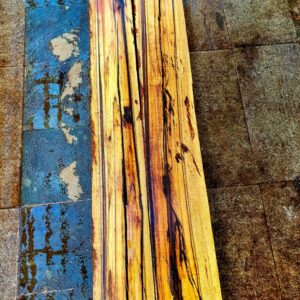Is this considered black and white Ebony? It’s a Diospyros but I’m not sure which species.
I am living in Phu Quoc island and I stumbled upon these Diospyros wood slabs. I got a distinct feeling they’re some kind of ebony but I wasn’t able to identify them. But anyways I liked the looks of ’em and price wasn’t that high here and I thought what the hell, let’s get it. Each slab measures 8″ wide, 3.6″ thick and 60″ long, and each was sold for $32.
So after I got home I started to research a bit more and they somewhat look similar to the Black and White Ebony, or Diospyros Malabarica on some online exotic wood sellers’ websites. So I’d like to hear your opinions: is this wood in the picture black and white ebony? What kind of species do you think they are? According to the woodsman who brought these slabs back, this Diospyros tree is a native to Phu Quoc island, and was uprooted by a storm 2 years ago.
Thank you for your answers.















Replies
While I've only used much smaller pieces of this species, it does look like B&W Ebony
https://www.wood-database.com/black-and-white-ebony/
So, your in Vietnam now?
Looking at pictures can make wood difficult to identify. Depending on the conditions it grew it in, climate , soil conditions,altitude etc. almost all types of wood can vary and still be the same species. Photo examples can be misleading. As a guess I would bet that that is diaspyros something and if malabarica is native to there then it most likely is.
My understanding is that pale moon or B&W ebony is very difficult to dry as it tends to warp and check badly and is usually fully coated with wax when milled -Even to the point of leaving it waxed through the drying process.. My guess is that would take a long time. Laos where most of that comes from has banned export but I don't know if that specific species is CITES listed but most ebonies are at this point. If it is you might have to keep it in Vietnam. I know about that island,, never been there,, supposed to have some nice beaches and is mostly national park.. and your sure it was legally obtained?
Because, I suppose, of the difficulty of drying it full on boards are difficult to obtain,here at least. Most of it that is available seems to be smaller stuff like turning blanks or guitar sets.
https://imgur.com/a/YyCS9MZ
Here are some more pictures of the wood when dry and of the end grain if it helps you see better.
Yes this wood has a tendency to crack itself quite easily and readily, as evident by my picture. As I said the tree that produced this wood was lying dead in the jungle for a couple years so that explains the cracking - nothing could have been done to prevent that - such is the reality of collecting dead trees. But this suit my philosophy anyways because I do not take any wood from living trees - just drift wood, long dead hardwood or reclaimed wood.
The island is indeed nice, lots of beaches, the national park is there, and there are plenty of beautiful wood that oughta interest a woodworker, like tembusu, calamander, ebony, and some shorea, hopea and sindora species.
I am not entirely sure of all the diospyros species here, hence my question. I might do a bit of research while I am at it. I know there are at least one diospyros species that either is or resembles black and white malabarica, and another diospyros species that either is or very much resembles diospyros mun or celebica, I could try to find out more. And yes I am living in Phu Quoc but I am not an American expat, I am Vietnamese so I have no intention of bringing any wood to America. Now I am debating what to do with these violent cracks. Should I just mix epoxy with black and fill them up, to have everything matching with the black ink like stripes?
This forum post is now archived. Commenting has been disabled